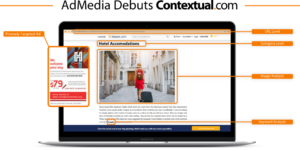Today, old methods of selling online are becoming obsolete. Many marketing executives have come to rely on techniques like search engine optimization (SEO), whitelists, and behavioral targeting. As the landscape surrounding customer data changes, it is likely that these methods will fall by the wayside.
What will replace the traditional methods of gaining ad traffic and visibility online? AdMedia explains how Contextual Targeting Advertising works and why it will continue to thrive even after the demise of third-party cookies. The unique capabilities of contextual advertising and the benefits of switching over to this system of reaching customers are discussed.
Contextual Targeting vs. Behavioral Targeting
Behavioral targeting refers to placing ads based on the consumer’s activities online. From their browsing history to purchase history, behavioral targeting can pinpoint the user’s likes and dislikes. However, behavioral targeting relies heavily on the collection of cookies, particularly third-party cookies.
Many consumers are dissatisfied with the amount of tracking that third-party cookies represent. They may feel that overly targeted ads that follow them everywhere online, from social media to web browsers, are creepy and intrusive.
Contextual targeting uses only first-party cookies or those stored on the website where the ads will be placed to construct its ad strategies. This provides some behavioral clues but does not lower itself to the level of chasing a consumer everywhere they go online.
Behavioral targeting and contextual targeting both have high levels of effectiveness. Still, companies should stop relying on mass behavioral targeting because the major data source in the third-party cookie is about to be eliminated in the coming years.
Upcoming Changes in Customer Data Collection
The third-party cookie is set to disappear. It is already being written out of popular browsers like Chrome, Safari, and Firefox. The reasons why third-party cookies met their downfall are many. Many customers balked at the idea of being tracked across the web by marketers who could build a complete picture of their buying and browsing habits. Privacy advocates were instrumental in convincing the big three browser companies to eliminate the use of third-party cookies.
The Shift to Contextual Targeting
Contextual targeting is coming to the forefront as one of the best methods for advertisers who used to rely on third-party cookies. Contextual targeting is a strategy that has been used since the beginning of advertising, and it involves placing the right ads in the right context. It can be used across all media, from online to TV and print.
For example, popular brands still buy advertising spots during shows that are relevant to what they sell. During sports programming, brands advertise beer and sports betting. During cooking shows, brands advertise supermarkets and food products. The central concept is that the right customer sees the right message.
How Contextual Targeting Works
Contextual targeting involves having the ability to select what type of programming that a company’s ads can appear beside. It also involves the use of keywords and keyphrases to a limited extent.
AdMedia’s system uses first-party commerce data to associate transactional data with URLs rather than depending on third-party cookies. This system is more efficient than the scattershot targeting methods used in the past, and it is privacy-protected for consumer safety and peace of mind.
The company uses a method known as Semantic Logic, which scans URLs, categories, images, and text to understand a webpage fully. This information is combined with first-party commerce data belonging to an existing audience to discover their preferences. When these two data sources have been assembled, ad specialists from AdMedia can choose the best tactics for producing useful messages.
Areas Where Contextual Targeting Advertising is Productive
Contextual targeting can be used across a number of different platforms. Email marketing, social media, search networks, TV, radio, and print ads can all be brought under the same umbrella.
Contextual targeting is especially effective for online ads and display advertising. It helps to fight ad fatigue, which happens when ads are continually placed out of context. Ideally, ads and content complement each other and add to the overall message.
Contextual Advertising is Privacy-Friendly
Consumers appreciate the use of contextual advertising because it does not rely on aggregate data collected about their personal preferences. The only information that the person placing the ad uses is the webpage’s content, analyzed via the proprietary process of Semantic Logic. This is how the advertising firm finds the best possible ad to put on the page.
Why Switch to Contextual Targeting?
One of the best reasons to use Contextual Targeting Advertising is that it is a fully dynamic system. As the content on the website changes, the ads will change as well. This means that the company placing the ad has a unique level of flexibility in controlling the message they wish to present to the public.
Another important reason to switch to contextual targeting, as explained earlier in this article, is that a major data source for behavioral advertising is going away for good. The third-party cookie will disappear in most major browsers, meaning that advertisers will no longer be able to use it to track the activities of web browsers online.
Working with a Dedicated Specialist
Your company may need to know how to update its advertising strategy, but you may not know where to start. Using a provider like AdMedia, which has been in operation for over 20 years, is a great place to begin. The company will be able to walk your marketing specialists through switching to contextual advertising and let them know how much customization of their ads they can expect.
Understanding Contextual Targeting
When you build a solid understanding of how contextual targeting can help your company and how you can take advantage of its unique capabilities, you will have a better idea of how it can help your company thrive online.
Written by Joan Bennet








